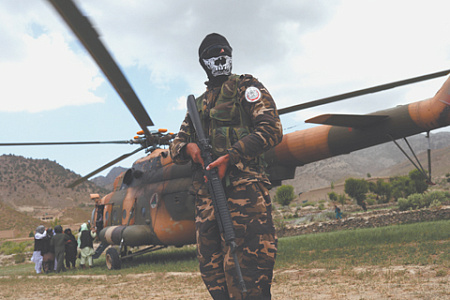Islamist groups are reviving in PakistanOn January 5, two employees of Pakistan's Interdepartmental Intelligence (ISI) Navid Sadiq and Nasir Butt, who were actively involved in the fight against terrorism in the region, were killed in the Khanewal district of the Punjab province of Pakistan.
Responsibility for the attack was claimed by both the Tehrik-e-Taliban Pakistan group (TTP, banned in the Russian Federation) and the little-known paramilitary formation Lashkar-e-Khorasan ("Army of Khorasan"), also known as the United Mujahideen of Khorasan. On January 26, the Lashkar-e-Khorasan group announced that its militants had committed a murder on religious grounds in the Dera Ismail Khan district of Khyber-Pakhtunkhwa province. The revival of Lashkar-e-Khorasan on the ever-changing extremist landscape of Pakistan after 10 years of inactivity coincides with the general increase in terrorist activity in the country. The list of other active groups includes the TTP, IG-Khorasan (banned in the Russian Federation), as well as the group of Hafiz Gul Bahadur from North Waziristan.
According to regional media, the Lashkar-e-Khorasan group was created in 2010 with the participation of terrorist organizations Al-Qaeda and the Haqqani Network (both banned in the Russian Federation). Its appearance was a response to the intensification of US drone attacks on the Afghan-Pakistani border. In the same year, the Americans carried out more than 100 attacks using unmanned aerial vehicles in the area.
The tasks of Lashkar-e-Khorasan were to collect data, as well as to track, capture and kill alleged "spies" who were accused of providing information to the CIA and the MIA in the former Federally Administered Tribal Territory (FTP), now united with Khyber Pakhtunkhwa province.
Initially, Lashkar-e-Khorasan was a loose network of militants recruited from other Islamist organizations, such as Hafiz Gul Bahadur's group and the TTP. The Punjabi Taliban, which included elements supporting Al-Qaeda from breakaway Kashmiri Islamist groups fighting against Pakistan, also supported Lashkar-e-Khorasan. However, over time, the organization turned into a specialized elite counterintelligence unit, numbering about 300 people, known for its signature black balaclava masks and Toyota Hilux cars.
Based in the tribal district of North Waziristan, Lashkar-e-Khorasan militants killed more than 250 alleged American and Pakistani informants in the FOOTP area. Before publicly executing suspected spies, some commanders of the group appealed to civilians with a warning against their joining the regional espionage networks of the United States and Pakistan. Sometimes warning letters on this subject were left next to the corpses of suspected spies. Lashkar-e-Khorasan militants often executed suspects by beheading bullet-riddled bodies or tying suicide belts to them.
At its peak in 2012, Lashkar-e-Khorasan was known as an extremist group that practiced brutal public executions in order to instill fear and terror in the civilian population of the region. As soon as the suspect was detained on charges of espionage, he was taken to the unofficial Islamic court "Dar-ul-Kaza", where the judges asked the suspect to explain the charges against him. If a person was found guilty (and this was the case in most cases), he was immediately executed.
For example, on May 10, 2011, Lashkar-e-Khorasan militants put suicide belts on alleged US spies and blew them up in front of a crowd. Similarly, in February 2011, the militant group beheaded six car mechanics in the Mir Ali district in North Waziristan. The accused were suspected of placing tracking chips in the cars of the leaders of the group, which were later fired upon by American drones.
This happened after the United States changed its strategy of eliminating militants in an attempt to minimize civilian casualties, moving from shelling residential complexes to hitting moving vehicles with extremists on board. The executed car mechanics were mostly from Bannu district of Khyber Pakhtunkhwa province.
In September 2011, the leadership of Lashkar-e-Khorasan came into conflict with the group of Hafiz Gul Bahadur because of the latter's pro-Pakistani position. The leaders of Lashkar-e-Khorasan claimed that Hafiz Gul Bahadur was a trusted person of the Pakistani military department. Earlier in the same month, the shura of his group decided to renounce and distance itself from the activities of Lashkar-e-Khorasan. After the meeting of the shura in the Miranshah and Mir Ali districts in North Waziristan, several copies of a two-page brochure were distributed, stating that after numerous attempts to reform the activities of Lashkar-e-Khorasan, Hafiz Gul Bahadur's group refused further cooperation with it.
Subsequently, Lashkar-e-Khorasan issued a statement in which it confirmed that it would not succumb to any pressure and would continue to conduct its operations against alleged American and Pakistani spies in the region.
Thus, the revival of Lashkar-e-Khorasan coincided with the activation of other extremist groups in Pakistan. It is noteworthy that the group of Hafiz Gul Bahadur, which, according to many testimonies, was associated with the Pakistani authorities in 2010, is now conducting anti-government subversive activities on the side of the TTP. At the same time, the current nature of relations between Lashkar-e-Khorasan and Hafiz Gul Bahadur's group remains unclear.
It is also possible that now Lashkar-e-Khorasan may be associated with the TPP. In a broader context, the revival of previously inactive Islamist groups in Pakistan indicates the transition of the conflict between extremist cells and government forces into a new phase.
Larisa Shashok

